Are you tired of drowning in an overwhelming sea of work demands? Do you feel your personal life is slowly slipping away due to deadlines at work?
It’s time to break free from the chains of never-ending to-do lists, late-night emails, and constant work-related stress. How? With some great tips for setting boundaries at work.
Picture a workplace where your well-being is respected, and your productivity soars. It’s not just wishful thinking; it’s entirely possible. All you need to do is learn the techniques for setting boundaries in the workplace.
The need for workplace boundaries
For many people, work bleeds into their personal lives more than they would like. Whether you are an entrepreneur or a professional, work gives us purpose, enables us to succeed and improves our social status. But just like everything else, even your career needs some healthy boundaries.
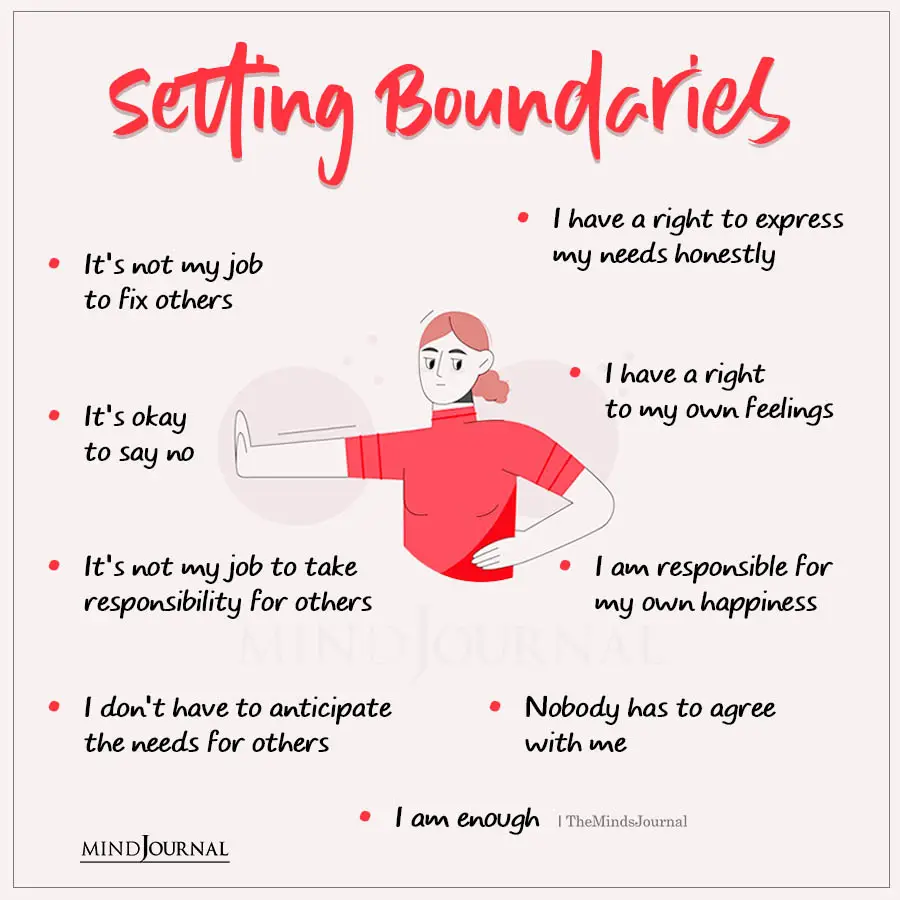
Whether it’s responding to off-hours emails and calls or allowing co-workers to take up too much of your personal time, setting boundaries with coworkers and boss can be challenging. However, setting firm yet reasonable limits is essential for maintaining a healthy work-life balance and preventing burnout.
Related: The Art of Setting Boundaries
But what exactly are workplace boundaries?
Boundaries at work refer to limits that help define what is acceptable and what is not in the workplace. They help establish clear expectations for behavior and communication, and can help create a more positive and productive work environment. It helps to –
- Protect your time and energy
- Prioritize what’s important to you
- Establish clear expectations
- Encourage self-care
- Promote respect in the workplace
With the right tips for setting boundaries at work, you can excel in your career while managing enough time to pursue your passions and spend quality time with your loved ones.
Once you learn the secrets of setting boundaries in the workplace, you will never have to surrender to the chaos. Remember, you have the power to take control and create a harmonious professional life.
13 Tips for setting boundaries at work
Workplace boundaries are essential for protecting your time and energy, helping you prioritize your work, establishing clear expectations, promoting self-care and respect, and creating a positive and productive work environment.
This is why it’s time to break free from the chains of never-ending to-do lists, late-night emails, and constant work-related stress. Let’s dive into the world of setting healthy boundaries at work, where balance and productivity coexist, and where your personal and professional lives intertwine harmoniously.
Here are some helpful and effective tips for setting boundaries at work –
1. Define your priorities
Before you can learn how to set boundaries at work, it’s important to determine what your priorities are. Identify your non-negotiables – the aspects of your life that hold the utmost importance.
This means taking the time to reflect on what matters most to you in your personal and professional life, and identifying the activities and tasks that align with those priorities. It can be anything from family commitments or personal hobbies to self-care routines.
Once you have a clear sense of your priorities, you can start to set healthy boundaries at work that help you achieve your goals and stay focused on what’s important. For example, if spending time with your family is a top priority, you may want to establish a boundary around working overtime or taking work home with you.
2. Know your limits
Next, focus on knowing what limits you actually want to set. Think about what behaviors, expectations, or workloads currently cross the line for you. Maybe you notice yourself working late too often or fielding too many calls on weekends.
Do an internal audit of your current work situation and identify exactly what needs to change to protect your time and energy. The more specific you can be, the easier it will be to implement strategies for setting boundaries with coworkers.
3. Set realistic and attainable limits
Boundaries need to be realistic and attainable for them to be sustainable in the long run. Avoid setting overly strict or rigid boundaries that may lead to unnecessary stress or feelings of failure.
Instead, assess your workload and capabilities realistically, and set boundaries that promote a healthy work-life balance without compromising your productivity or job responsibilities. This is one of the most practical and effective tips for setting boundaries at work.
4. Communicate your boundaries clearly
Once you know your limits, communicate them to colleagues and managers in a clear and concise manner. Explain your boundaries using “I” statements focusing on your needs, not any judgments of others.
For example, you could say, “I need to keep my workdays from 8am to 5pm in order to balance my work and personal responsibilities.” Avoid vague language and give concrete examples of when your boundaries apply, like saying no to off-hours meetings or last-minute requests.
However, it’s important to be firm but polite when setting boundaries with coworkers. Explain why the boundary is important to you. For instance, you might say, “I’m sorry, but I won’t be able to take on any additional projects this month because I need to focus on meeting the deadline for my current project.”
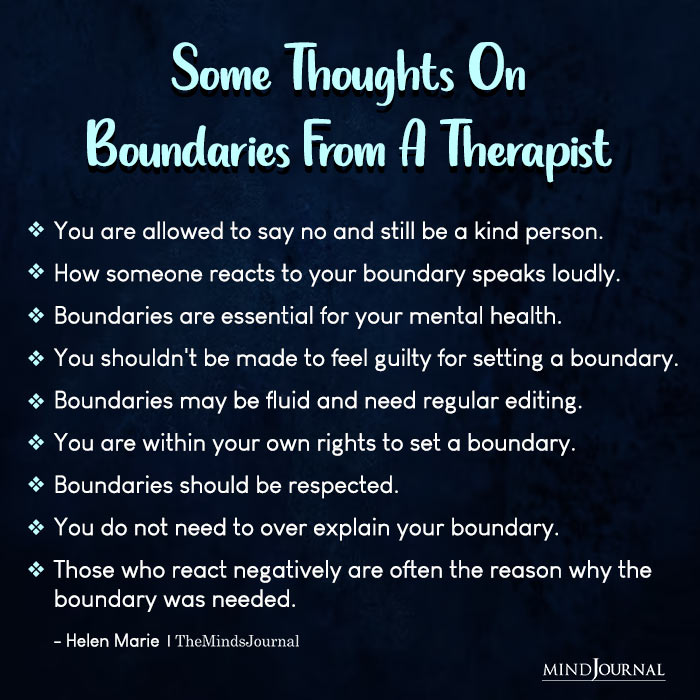
The clearer and more specific you are with your boundaries, the easier it will be for people to respect them. Don’t wait to communicate until you’re feeling overwhelmed or burnt out to set healthy boundaries at work.
Be proactive and establish them early on, so that everyone knows what to expect. This is one of the most effective ways to set boundaries at work.
Related: 10 Signs Of Healthy Boundaries
5. Be firm but respectful
One of the simplest ways to set boundaries at work is to be assertive but polite. When colleagues test your limits, stand your ground in an assertive yet respectful manner. Don’t JADE (justify, argue, defend, or explain), simply restate your boundary.
For instance, if a coworker asks you to take on an additional task at the last minute, you can say, “Unfortunately, that doesn’t work for me as I already have certain priorities.” Or if a colleague texts you on a weekend, you might respond, “Thanks for thinking of me! However, I try not to check work communication on weekends.” Be polite yet firm so people know you mean business.
Want some more effective tips for setting boundaries at work? Then keep reading.
6. Establish dedicated work hours
In the age of remote work and flexible schedules, it can be tempting to blur the lines between professional and personal life. However, it’s crucial to set dedicated work hours and communicate them clearly to your team.
Define specific time slots during which you are available for work-related tasks, and stick to these boundaries as much as possible. This one is one of the best tips for setting boundaries at work that will help you to avoid burnout and encourage others to respect your off-hours.
7. Use technology to set limits on your availability
One of the biggest challenges of modern work life is the expectation of constant availability. Leverage technology to establish specific times when you will check your email or respond to messages.
Establish digital boundaries and set an out-of-office auto-reply on your emails for weekends and after work hours.
Turn off work phone and email notifications on your personal devices when not on the clock. You can also let your team know in advance that you’ll be totally unplugged and unavailable during those times.
Remove work apps from your phone, if possible. Only check emails at designated times during the workday. Technology makes blurring work and personal life all too easy, so use it to help you stick to your healthy boundaries at work instead.
It’s important to remember that setting limits on your availability doesn’t mean you’re not committed to your job. It simply means that you recognize the importance of taking time for yourself and recharging, so that you can perform at your best when you’re on the clock.
8. Delegate more work when possible
Constantly taking on more work and responsibilities can leave you feeling overwhelmed. To reclaim some control, look for ways to delegate tasks to coworkers. This allows you to stick to the workload you originally committed to without overburdening yourself.
Delegating more work when reasonable can be an important part of enforcing boundaries and prioritizing your own wellbeing at work. This is one of the excellent ways to set boundaries at work.
Related: Setting Boundaries That are Clear and Well-Expressed
9. Learn to say “no” without anxiety
Saying “no” can be difficult, especially if you’re someone who likes to please others or has a hard time saying no to requests. However, learning to say “no” confidently and without anxiety is a crucial part of setting boundaries at work.
Start small by turning down one or two extra requests at first. You can do so politely, by explaining that you’re already at capacity or that the request doesn’t align with your current responsibilities.
With practice, saying “no” gets easier and you realize the world keeps spinning. Remember that your colleagues will respect you more for having clear limits versus burning yourself out by taking on too much. Saying “no” confidently is among the most effective tips for setting boundaries at work.
10. Create a schedule and stick to it
Creating a schedule can help you with setting boundaries in the workplace. This means setting specific times for tasks, meetings, and breaks, and sticking to them as much as possible during the workday.
When creating your schedule, be sure to include time for self-care and other activities that are important to you, such as exercise, hobbies, or spending time with loved ones. By scheduling these activities in advance, you can ensure that they are a priority and that you don’t overcommit yourself to work.
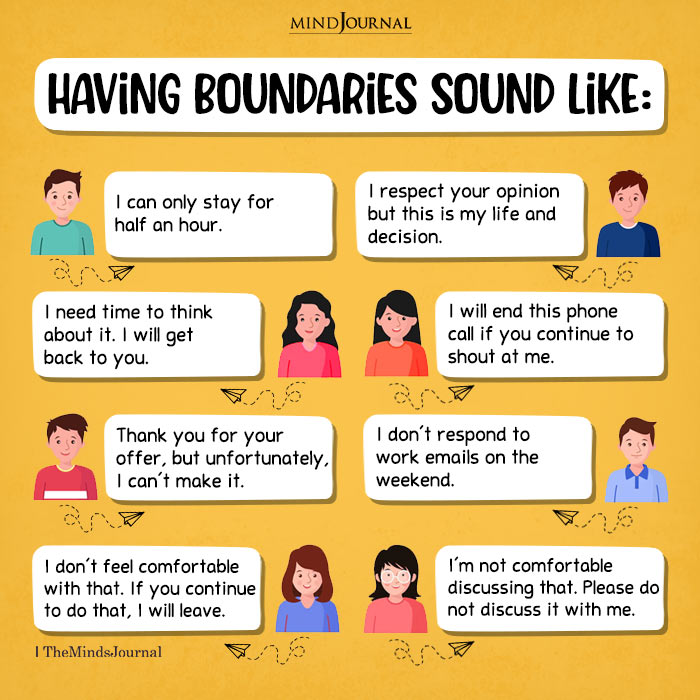
Looking for more helpful tips for setting boundaries at work? Read on.
11. Be open to adjustments
While it’s important to establish healthy boundaries at work, it’s also important to be open to adjustments when necessary. This means recognizing when your current boundaries aren’t working and being willing to make changes to improve your work-life balance.
For example, if you find that you’re consistently working overtime and it’s affecting your wellbeing, you may need to adjust your workload or delegate tasks to others.
Or, if you find that your current schedule isn’t allowing you to take breaks or engage in self-care, you may need to adjust your schedule to better accommodate these needs.
12. Avoid feeling guilty about setting boundaries in the workplace
Many people feel guilt at the thought of setting boundaries with coworkers, thinking they should always be available to help. However, you must prioritize your own work-life balance and mental health.
Remember that setting clear limits will actually allow you to perform better at work during scheduled hours.
Remind yourself that your co-workers and company will survive without you being “on” 24/7. Have confidence that you deserve time for yourself and your family. This is one of the crucial ways to set boundaries at work.
Related: 10 Reasons Why Your Boundaries Don’t Work
13. Practice self-care and mindfulness
Practicing self-care and mindfulness is among the most important tips for setting boundaries at work. Take regular breaks, prioritize exercise and healthy eating, and engage in activities that rejuvenate your mind and body.
Additionally, mindfulness practices such as meditation or deep breathing exercises can help you manage stress and maintain a clear focus. By nurturing your well-being, you’ll be better equipped to establish and maintain boundaries that support your overall professional success.
Setting boundaries is not selfish or unprofessional. In fact, it’s an important step in taking care of yourself and achieving your goals. It’s important to communicate your boundaries clearly to your colleagues and boss, and to be willing to adjust them as necessary.
Setting boundaries at work examples
Wondering what setting boundaries in the workplace actually looks like in the real world? Here are some setting boundaries at work examples that will help you better understand the above tips for setting boundaries at work –
1. Time boundaries
Time boundaries are limits on when and how long you work. For example, you might set a boundary that you won’t work on weekends or after a certain time in the evening. Or, you might set a boundary that you need to take a lunch break at a certain time each day. You may also –
- Avoid checking work emails or engaging in work-related tasks outside of designated working hours.
- Clearly communicate your availability for meetings and appointments, ensuring they align with your established work schedule.
2. Task boundaries
This is one of the most important setting boundaries at work examples. Task boundaries are limits on the types of tasks or projects you are willing to work on and the workload you can practically take on.
For example, you might set a boundary that you won’t take on any new projects until you have finished your current workload. Or, you might set a boundary that you won’t work on projects that don’t align with your values or interests. You can –
- Communicate your workload capacity to your supervisor and team members to avoid taking on excessive tasks that could lead to burnout.
- Prioritize your tasks based on their urgency and importance, ensuring that you focus on high-priority assignments first.
3. Communication boundaries
Communication boundaries are perhaps the most widely observed setting boundaries at work examples. These refer to limits on how often or in what ways you communicate with colleagues or clients.
For example, you might set a boundary that you won’t respond to work emails after a certain time in the evening or on weekends. Or, you might set a boundary that you won’t take work calls during your lunch break. You may want to –
- Set aside specific blocks of time for uninterrupted work, during which you avoid unnecessary interruptions or distractions.
- Establish preferred modes of communication (email, phone, in-person) and communicate them to colleagues, allowing for more efficient and focused communication.
4. Personal space boundaries
Physical or personal space boundaries are limits on physical contact or proximity in the workplace. It could mean keeping personal belongings in designated areas, minimizing personal distractions in your workspace, or requesting privacy when necessary.
For example, you might set a boundary that you don’t want people to touch you or invade your personal space without permission. Or, you might set a boundary that you don’t want people to take your things or use your workspace without permission. You may –
- Create a designated workspace that allows you to concentrate and separate work from personal life.
- Request privacy during specific times when you need to concentrate on tasks that require undivided attention.
Related: How Healthy Boundaries Help Protect Your Personal Space
Want more setting boundaries at work examples? Read on.
5. Meeting boundaries
This involves being selective about the meetings you attend and ensuring they align with your priorities and responsibilities. Request agendas in advance to determine if your presence is necessary, and if possible, propose alternative solutions such as written updates or concise summaries to save time. You can –
- Assess meeting invitations to ensure they align with your responsibilities and contribute to your goals.
- Request clear agendas and objectives for meetings, ensuring that your time is used effectively and productively.
6. Technology boundaries
It involves defining limits on checking work-related emails or messages outside of working hours, avoiding excessive use of personal devices for work purposes, and setting healthy screen time habits to maintain a healthy work-life balance. You may want to –
- Silence non-essential notifications during work hours to minimize distractions and maintain focus.
- Set boundaries for personal device use during work hours, avoiding excessive personal browsing or social media engagement.
7. Emotional boundaries
Emotional boundaries involve maintaining a healthy separation between personal emotions and work-related matters. It’s important to develop coping strategies to handle stress, criticism, and conflicts at work, while also knowing when to seek support from supervisors, mentors, or professional resources. You may –
- Develop certain coping mechanisms to manage stress and emotional challenges at work, such as taking short breaks for self-care or seeking support from colleagues or mentors.
- Practice separating personal emotions from work-related situations to maintain professionalism and productivity.
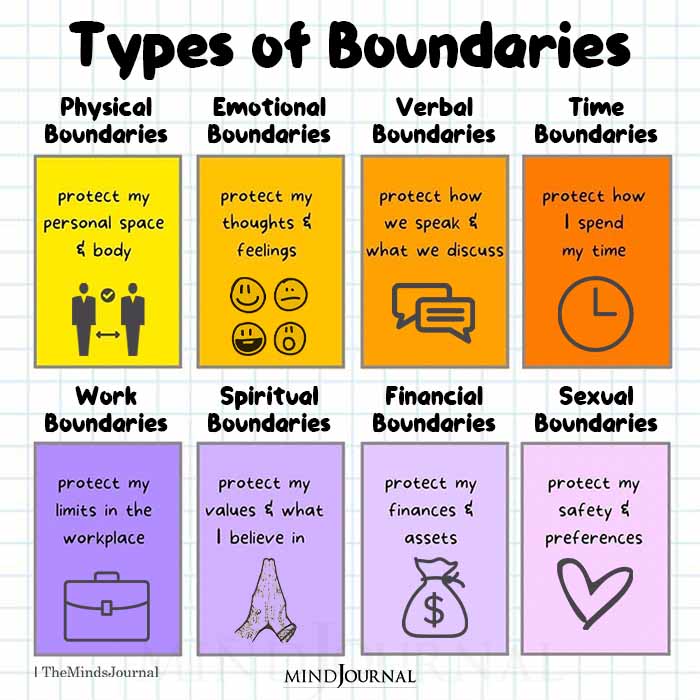
Apart from following the tips for setting boundaries at work and the examples shared above, it is also important to set personal and professional boundaries.
8. Personal boundaries
These are limits on conversations or interactions with colleagues that involve personal topics or issues. For example, you might set a boundary that you don’t want to discuss your personal life or problems with colleagues, or that you don’t want to engage in gossip or negative talk about others.
This is one of the most important setting boundaries at work examples for your mental well-being.
9. Professional boundaries
These are limits on behavior or interactions that are not appropriate in the workplace. For example, you might set a boundary that you don’t want to be subjected to harassment or discrimination, or that you don’t want to engage in behavior that could be perceived as unprofessional or unethical.
These are just a few examples of the many different types of boundaries that can exist in the workplace. By setting and maintaining healthy boundaries at work, you can create a more positive and respectful work environment, and ensure that you are able to do your best work without sacrificing your well-being.
Related: 5 Empowering Techniques for Setting Clear Boundaries in Crucial Areas of Life
How to set boundaries with toxic boss
Is setting boundaries at work with boss possible? Yes, but it won’t be easy. While the helpful tips for setting boundaries at work can help you build a better work-life balance, setting boundaries with a toxic boss can be challenging, but it’s important for your mental health and well-being. Here are some strategies that may help:
1. Be clear and direct
When communicating your boundaries to an exploitative boss, it’s important to be clear and direct. Explain what behaviors are unacceptable and what you need in order to do your job effectively. Use “I” statements to avoid sounding accusatory, and stick to the facts.
2. Document everything
Keep a record of any incidents or interactions with your boss that violate your boundaries. This can be helpful if you need to escalate the situation to HR or your boss’s supervisor. This is an excellent tip to remember when setting boundaries at work with boss.
3. Seek support
Talk to colleagues or a mentor who can offer support and advice. Consider seeking the help of a therapist or coach who can help you develop coping strategies and navigate the situation. Support is crucial when figuring out how to set boundaries with toxic boss.
4. Set consequences
If your boss continues to violate your boundaries, it may be necessary to set consequences. For example, you may need to escalate the situation to HR or consider finding a new job if the situation is not improving. This is another effective way of setting boundaries at work with boss.
5. Stay professional
While it can be tempting to lash out or become emotional when dealing with a toxic boss, it’s important to stay professional. Keep your focus on the facts and your boundaries, and avoid getting drawn into emotional arguments. This is how to set boundaries with toxic boss.
6. Take care of yourself
Dealing with a toxic boss can be stressful and draining. Make sure to take care of yourself by getting enough sleep, eating well, and engaging in self-care activities that help you recharge and stay healthy. This can include things like exercise, meditation, or spending time with loved ones.
Remember, setting boundaries at work with boss may be difficult, but it’s important for your well-being. By following the above tips for setting boundaries at work, you can establish clear limits and expectations for your boss’s behavior, while also maintaining a positive and professional relationship with your colleagues.
Related: 7 Tips For Setting Boundaries With Toxic People
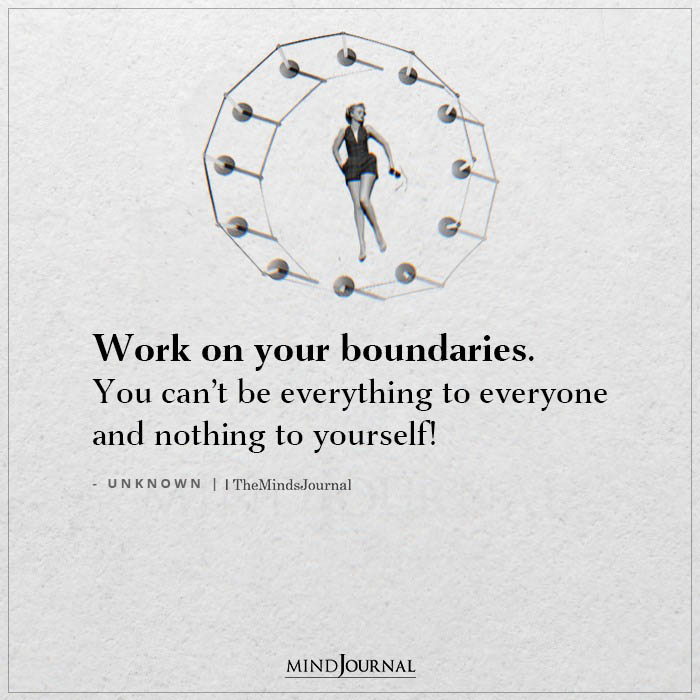
Healthy boundaries lead to a healthy work-life balance
Setting clear boundaries at work requires honest self-assessment, effective communication, and the confidence to enforce your limits assertively yet respectfully. While it may be tough at first, implementing a few key tips can make a huge difference in reclaiming your time and energy.
Ultimately, prioritizing your own work-life balance will allow you to avoid burnout and perform at your best on the job. With practice and perseverance, you can gain the skills needed to implement healthy boundaries that serve both you and your team well.
Start small and build up – your wellbeing at work depends on it!
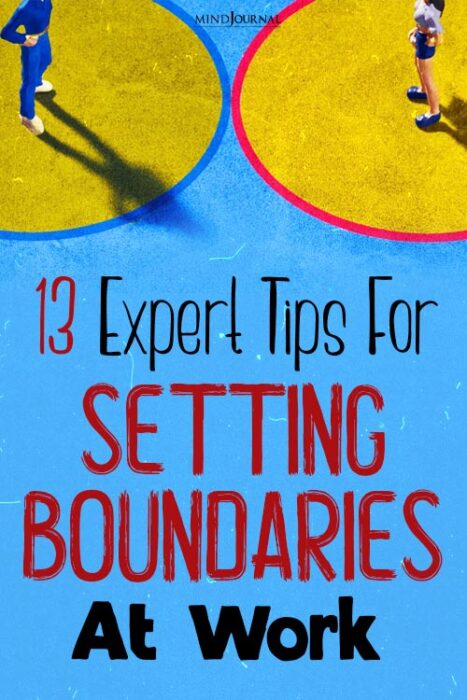








Leave a Reply
You must be logged in to post a comment.